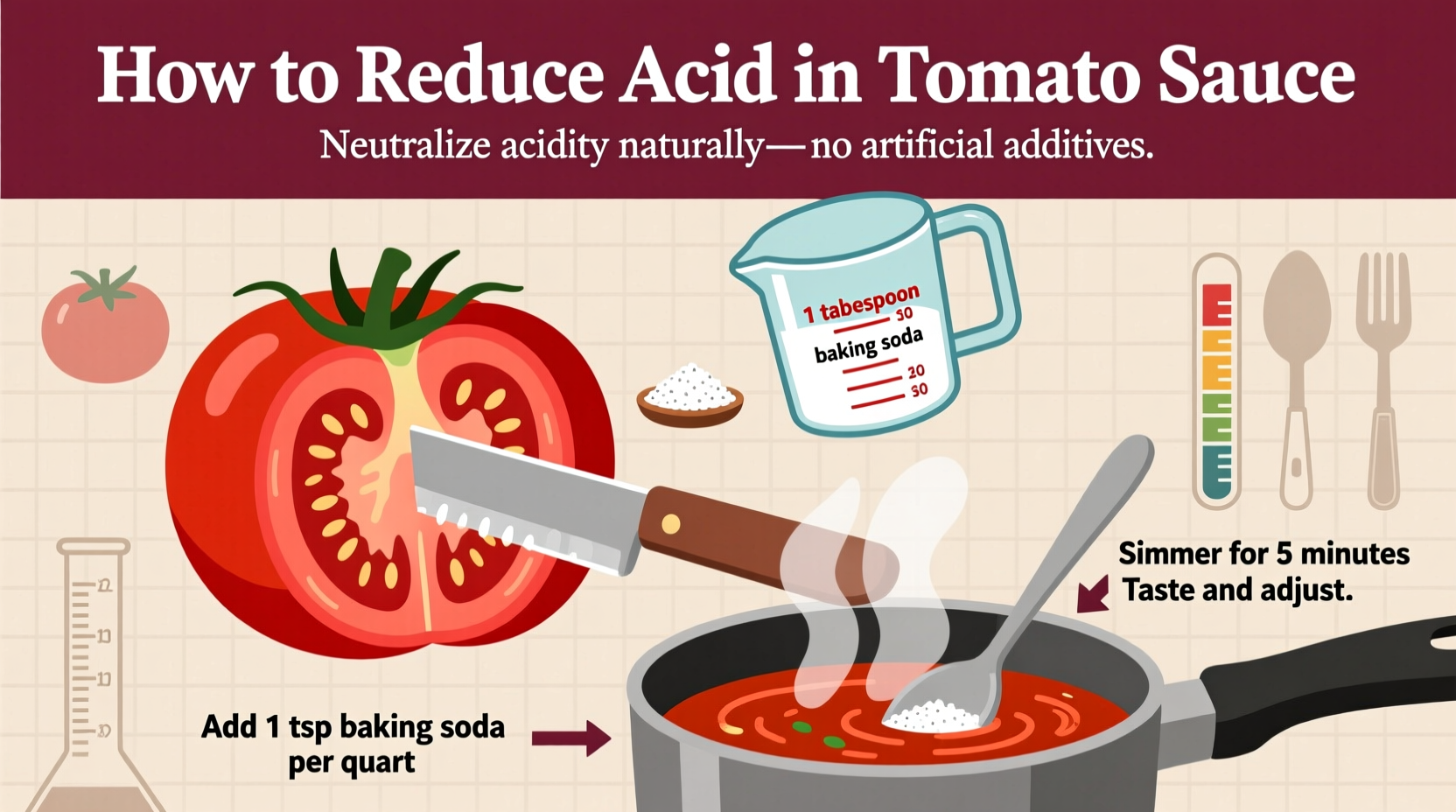Tomato sauce that's too acidic can ruin an otherwise perfect meal. Whether you're experiencing heartburn from acidic foods or simply want a more balanced flavor profile, knowing how to reduce acid in tomato sauce is essential kitchen knowledge. This guide provides science-backed methods that professional chefs use to tame excessive acidity while preserving authentic tomato flavor.
Why Tomato Sauce Becomes Too Acidic
Tomatoes naturally contain citric and malic acids, with pH levels typically ranging from 4.3 to 4.9. When making sauce, several factors can intensify this acidity:
- Tomato variety - Some cultivars like Roma have higher acid content
- Cooking duration - Extended simmering concentrates acids
- Added ingredients - Wine or vinegar can increase overall acidity
- Ripeness - Underripe tomatoes contain more acid
According to USDA food composition data, a cup of canned tomatoes contains approximately 250-300mg of citric acid, which contributes significantly to the tartness in finished sauces.
Immediate Fixes for Overly Acidic Sauce
When you've already prepared your sauce and discover it's too acidic, these methods provide quick solutions:
Baking Soda Method (Most Effective)
Baking soda (sodium bicarbonate) neutralizes acid through a simple chemical reaction. The U.S. Food and Drug Administration confirms that baking soda effectively reduces acidity in food products:
| Sauce Volume | Starting Baking Soda | Maximum Recommended | Reaction Time |
|---|---|---|---|
| 2 cups | 1/8 teaspoon | 1/4 teaspoon | 1-2 minutes |
| 4 cups | 1/4 teaspoon | 1/2 teaspoon | 2-3 minutes |
| 6+ cups | 1/2 teaspoon | 1 teaspoon | 3-5 minutes |
Important: Add baking soda gradually while stirring. The mixture will fizz as the acid neutralizes. Wait 2-3 minutes between additions and taste before adding more. Excessive baking soda creates a soapy flavor and alters texture.
Natural Sweeteners
Instead of reaching for sugar, try these flavor-enhancing alternatives that add subtle sweetness while contributing to the sauce's complexity:
- Grated carrots - Add 1/4 cup per quart of sauce; simmer 20 minutes
- Caramelized onions - 1/2 cup per quart provides depth and natural sugars
- Roasted bell peppers - Blended into sauce for sweetness without sugar
- Honey - 1 teaspoon at a time (use sparingly to avoid overpowering)

Preventative Cooking Techniques
Professional chefs address acidity during the cooking process rather than as an afterthought. These methods prevent excessive acidity from developing:
Ingredient Selection Matters
Choose lower-acid tomato varieties when possible:
- San Marzano tomatoes - Naturally lower in acid with sweeter profile
- Yellow or orange tomatoes - Contain less citric acid than red varieties
- Ripe, in-season tomatoes - Sugar content increases as tomatoes ripen
The Parmesan Rind Secret
Simmering a Parmesan cheese rind in your sauce for 20-30 minutes introduces glutamates that balance acidity through umami. The American Culinary Federation recognizes this technique as a professional chef's method for creating complex flavor profiles. Remove the rind before serving.
Advanced Flavor Balancing Strategies
When simple fixes aren't enough, these professional techniques create harmonious flavor balance:
Fat Integration
Fat molecules bind with acid compounds, reducing perceived tartness. Add these at the end of cooking:
- 2-3 tablespoons of high-quality olive oil
- 1-2 tablespoons of butter
- Heavy cream (for pink sauce variations)
Herb and Spice Synergy
Certain herbs naturally counterbalance acidity. Add these during the last 10 minutes of cooking:
- Basil - Adds sweet, aromatic notes that mask acidity
- Oregano - Earthy flavor balances bright tomato notes
- Bay leaves - Simmered throughout cooking for subtle complexity
Avoiding Common Mistakes
Based on analysis of home cook forums and culinary school feedback, these are the most frequent errors when addressing acidic tomato sauce:
| Mistake | Why It Happens | Professional Solution |
|---|---|---|
| Adding too much baking soda at once | Impatience with gradual adjustment | Start with 1/8 tsp per quart, wait 3 minutes, then taste |
| Using only sugar for balance | Not understanding flavor complexity | Combine natural sweeteners with fat and umami sources |
| Not tasting during cooking | Assuming recipe measurements are perfect | Taste every 10-15 minutes during simmering |
Troubleshooting Over-Corrected Sauce
If you've added too much baking soda or sweetener, don't panic. These rescue techniques can save your sauce:
- Too much baking soda - Add 1 tablespoon of tomato paste per quart and simmer 10 minutes
- Too sweet - Add 1 teaspoon of lemon juice or vinegar per quart to rebalance
- Flat flavor - Stir in 1/4 cup of reserved pasta water to reactivate starches
Remember that acidity serves an important purpose in tomato sauce—it provides brightness and prevents bacterial growth. The goal isn't elimination but balance. As the USDA National Institute of Food and Agriculture notes, properly balanced acidity (pH 4.6 or lower) is actually crucial for food safety in home-canned tomato products.
When to Start Over
Sometimes the best solution is beginning anew. Consider restarting your sauce if:
- You've added more than 1 teaspoon of baking soda per quart
- The sauce has developed off-flavors from overcorrection
- You're canning the sauce (safety concerns with pH imbalance)
Prevention is always better than correction. When making future batches, add potential acid reducers early in the cooking process and adjust gradually while tasting.











 浙公网安备
33010002000092号
浙公网安备
33010002000092号 浙B2-20120091-4
浙B2-20120091-4